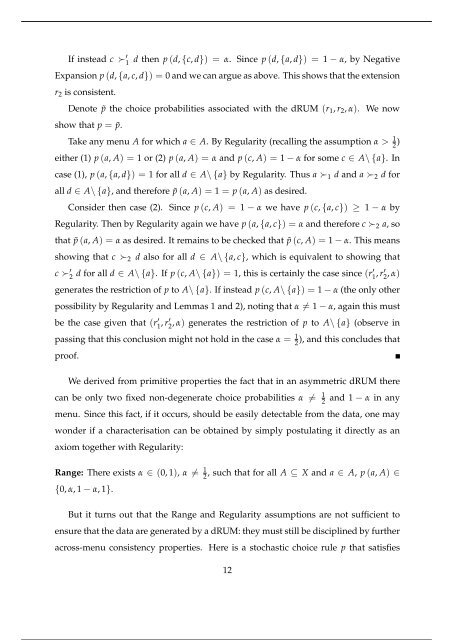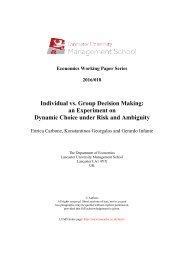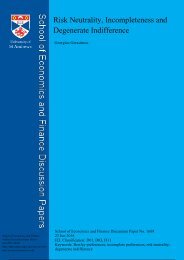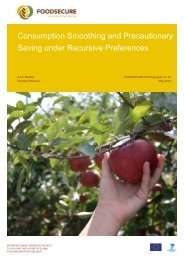Dual Random Utility Maximisation
n?u=RePEc:san:wpecon:1605&r=upt
n?u=RePEc:san:wpecon:1605&r=upt
You also want an ePaper? Increase the reach of your titles
YUMPU automatically turns print PDFs into web optimized ePapers that Google loves.
If instead c ≻ ′ 1<br />
d then p (d, {c, d}) = α. Since p (d, {a, d}) = 1 − α, by Negative<br />
Expansion p (d, {a, c, d}) = 0 and we can argue as above. This shows that the extension<br />
r 2 is consistent.<br />
Denote ˜p the choice probabilities associated with the dRUM (r 1 , r 2 , α). We now<br />
show that p = ˜p.<br />
Take any menu A for which a ∈ A. By Regularity (recalling the assumption α > 1 2 )<br />
either (1) p (a, A) = 1 or (2) p (a, A) = α and p (c, A) = 1 − α for some c ∈ A\ {a}. In<br />
case (1), p (a, {a, d}) = 1 for all d ∈ A\ {a} by Regularity. Thus a ≻ 1 d and a ≻ 2 d for<br />
all d ∈ A\ {a}, and therefore ˜p (a, A) = 1 = p (a, A) as desired.<br />
Consider then case (2). Since p (c, A) = 1 − α we have p (c, {a, c}) ≥ 1 − α by<br />
Regularity. Then by Regularity again we have p (a, {a, c}) = α and therefore c ≻ 2 a, so<br />
that ˜p (a, A) = α as desired. It remains to be checked that ˜p (c, A) = 1 − α. This means<br />
showing that c ≻ 2 d also for all d ∈ A\ {a, c}, which is equivalent to showing that<br />
c ≻ ′ 2 d for all d ∈ A\ {a}. If p (c, A\ {a}) = 1, this is certainly the case since (r′ 1 , r′ 2 , α)<br />
generates the restriction of p to A\ {a}. If instead p (c, A\ {a}) = 1 − α (the only other<br />
possibility by Regularity and Lemmas 1 and 2), noting that α ̸= 1 − α, again this must<br />
be the case given that (r<br />
1 ′ , r′ 2<br />
, α) generates the restriction of p to A\ {a} (observe in<br />
passing that this conclusion might not hold in the case α =<br />
2 1 ), and this concludes that<br />
proof.<br />
We derived from primitive properties the fact that in an asymmetric dRUM there<br />
can be only two fixed non-degenerate choice probabilities α ̸= 1 2<br />
and 1 − α in any<br />
menu. Since this fact, if it occurs, should be easily detectable from the data, one may<br />
wonder if a characterisation can be obtained by simply postulating it directly as an<br />
axiom together with Regularity:<br />
Range: There exists α ∈ (0, 1), α ̸=<br />
2 1 , such that for all A ⊆ X and a ∈ A, p (a, A) ∈<br />
{0, α, 1 − α, 1}.<br />
But it turns out that the Range and Regularity assumptions are not sufficient to<br />
ensure that the data are generated by a dRUM: they must still be disciplined by further<br />
across-menu consistency properties. Here is a stochastic choice rule p that satisfies<br />
12






